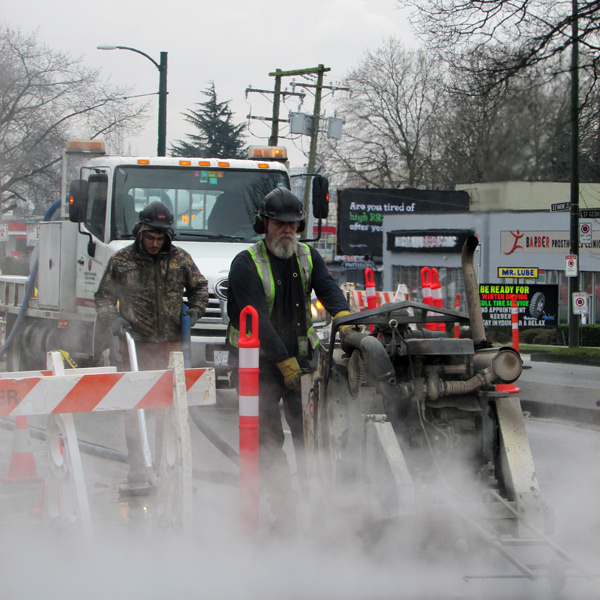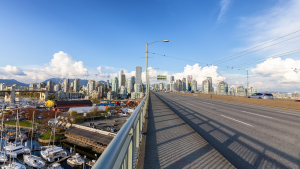In January, the City of Vancouver put shovels in the ground to begin a major $30 million upgrade along five kilometres of Marine Drive on the city’s south side with sewer, water and intersection work estimated to take two years to complete.
“It is the largest infrastructure in our current four-year capital plan,” said Andrea Becker, who is the acting director for water and sewer design, construction and operations within the City of Vancouver’s engineering services department.
While the majority of work is being undertaken by city crews, speciality work and equipment is being contracted out as well as traffic control. Urban Sawing & Scanning is providing the cutting of the pavement and concrete to gain access for trenching.
The upgrade has required pulling together several construction teams in order to co–ordinate the trenching, pipe placement and subsequent roadway paving work in order to minimized traffic disruptions, Becker said.
“It is a decade in the making,” she said.
The five kilometre stretch of southeast and southwest Marine Drive lies between Victoria Drive (on the east) and Oak Street (on the west) and crews began working mid-way at the Fraser Street and southeastern Marine intersection. The water line replacement crew is working east and the sewer line crew going west. The crews will have to move over the area twice.

“There will be some hop-scotching,” said Becker. “We don’t want crews working on top of each other.”
The work addresses a number of infrastructure concerns. The Marine Drive area is a high-volume traffic arterial carrying 34,000 vehicles daily, has a growing population as new multi-family structures are rising in the area and the stretch has aging water and sewer lines.
The high traffic volume has taken its toll on the road service with cracks, rutting and subsidence and resurfacing was needed. But, before resurfacing started, Becker said the decision was made to ensure the infrastructure below the new roadway was also sound. The project will also upgrade traffic signals at eight intersections and include installing left turn arrows at two intersections in a bid to reduce collisions.
The Fraser Street and S.E. Marine junction, where work began, was once a service link to the early south Vancouver farms on the city’s southern slope and the mills along the Fraser River at the turn of the century.
A portion of the water pipe slated for replacement dates back to 1913 but the remainder of the sewer and water lines are what Becker calls middle aged and were installed in the 1950s. The old pipe diameters range from 150 to 300 millimetres and are a combination of concrete, clay and PVC materials. They will be replaced with concrete and PVC while the old cast iron water lines will be replaced with Ductile iron class 52 double cement lined TR-Flex joints that have rubberized gaskets.
The water lines are only a metre below the road surface with sewer lines deeper. The impact of traffic’s high volume and heavy load vehicle can transfer impact onto the water lines below.
“The old cast iron pipe can be brittle,” Becker said, adding the old solder used on pipes is also brittle and inflexible. “If there is a lot of traffic, they can fail.”
Ongoing seismic stability is also a concern. Becker said the TR-Flex pipe is a restrained pipe system that provides additional strength and resilience, compared to regular push-on joint systems, to prevent any longitudinal separation of the joints during seismic events.
They also support thrust restraint design that reduces the need for concrete thrust blocks and gravity blocks in congested corridors. The new pipe will be part of Vancouver’s backbone of more seismically resilient watermains.
Becker said one of the interesting features of the pipe being used is that it is made from recycled steel and iron from vehicles and supplied by Canada Pipe Co., part of the McWane family of companies and manufactured in Utah. The pipe for the site is from Canada Pipe’s Abbottsford distributor. The sewer concrete pipe is made locally by Ocean Concrete in Vancouver while the PVC Delta pipe is also made locally.
Some portion of the old cast iron water and sewer systems will be removed, Becker said, at other sections it will be easier to parallel new pipe and leave the old pipe in situ.
The one-kilometre sewer upgrade will consist of twinning the existing one-line system to separate storm runoff from sewage. The twinning is part of a move throughout Metro Vancouver to meet the B.C. Ministry of Environment’s requirement that all sewers are separated by 2050. Older municipalities, such as Vancouver, Burnaby and New Westminster have a greater portion of their sewer system in single line systems than other Lower Mainland suburban municipalities that have expanded and in doing so made an early conversion to the dual system.
Vancouver has an estimated 2,100 kilometres of single line pipe of which 54 per cent has been converted to twin lines, said Becker, adding the one-kilometre sewer replacement along Marine Drive contributes to the city’s commitment to replace one per cent of the system per year. Currently, because of budget constraints and manpower, the city has been operating at .7 per cent, she said.











Recent Comments
comments for this post are closed